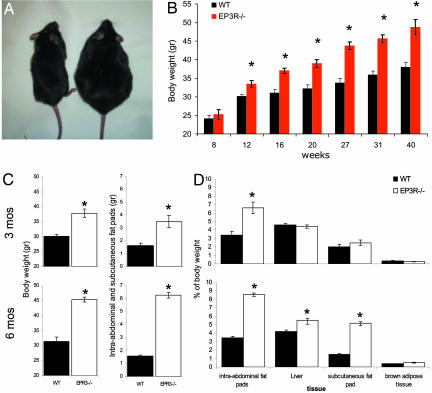Fig. 1.
EP3R−/− mice show an increase in body weight that results in an obese phenotype. (A) A male EP3R−/− mouse (Right) and a WT littermate (Left) at 30 weeks of age. (B) Measurement of body weight at different time points shows that overweight becomes significant on EP3R−/− mice after week 12 (t = 3.17; P = 0.048). Evaluation of body weight at different time points shows a consistent increment of body weight in EP3R−/− mice at weeks 16 (t = 5.29; P = 0.0001), 20 (t = 4.41; P = 0.001), 27 (t = 5.97; P = 0.0001), 31 (t = 6.36; P = 0.0001), and 40 (t = 4.7; P = 0.0006). After week 30, weight differences are ≈30% of the body weight of corresponding WT littermate controls. (C) Early deposition of intraabdominal and subcutaneous fat pads in EP3R−/− mice at 3 months of age becomes an important contributor to body weight gain (t = 3.79; P = 0.0053); at 6 months of age, the contribution becomes higher (t = 18.36; P = 0.0001). (D) At 3 months, intraabdominal fat pads are the main site of fat accumulation in EP3R−/− mice (t = 4.35; P = 0.0024). At 6 months, the intraabdominal fat pads (t = 19.55; P = 0.0001), liver (t = 4.68; P = 0.0016), and subcutaneous fat pads (t = 12.09; P = 0.0001) become important sources of fat deposits in EP3R−/− mice. Asterisks indicate significant differences at each given point. For P values, see above.

